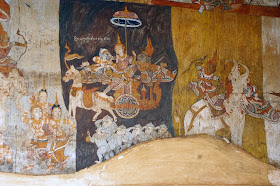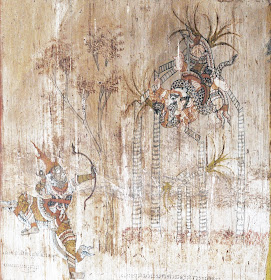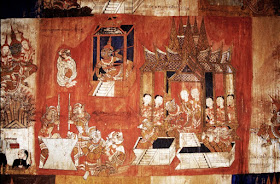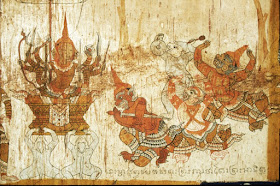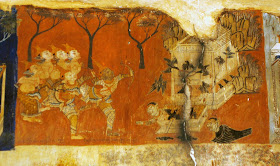Wat Bo: My Concluding Personal View on the Murals
In my book of 2015 (In the Shadow of Rama) I took into consideration the Thai Ramakien as the most explanatory text of the murals of Wat Bo. Now I start to give more wait to the story of a Cambodian text, the Trai Beht, especially in the narrative of Mi Chak (in French by Bizot 1989).
In my book of 2015 (In the Shadow of Rama) I took into consideration the Thai Ramakien as the most explanatory text of the murals of Wat Bo. Now I start to give more wait to the story of a Cambodian text, the Trai Beht, especially in the narrative of Mi Chak (in French by Bizot 1989).
The Trai Beht and the version
of MiChak explains most of the events painted on the western wall of Wat Bo,
but in a different sequential order of painted murals,
In the 1960s, the bard Mi Chak narrated what he
had memorized from a palm leaf manuscript of the monastery of Angkor Wat South
in 1920 (Bizot 1973) when he was a bonze for nine years. Because his excellent
memory, diction, and clear voice he soon became a celebrated storyteller. He
was engaged by François Bizot to record his story on tape in 1969 to be published it in1989 (Roveda &Yem,
2009: 238) This is the text to which I
prefer to use, being neatly narrated and illustrated with the murals of the
Silver Pagoda of Phnom Penh.
Over the years I have formulated the theory that
in Cambodia the Khmer elite used, since the 8th century, the Sanskrit
language that had its best development in the 12th century with appreciation
of Sanskrit Valmiki’s Ramayana. It seems
that Sanskrit gradually disappeared by the 15thcentury with social,
economic and religious dramatic changes. Sankrit had been the language of the
aristocracy and purohitas (master
gurus), the Cambodian language used by lay people becoming populist already
from the time of Jayavarman VII. Pali language was exclusive of the samga.
All Southeastern Asia countries were touched by
the Indian Ramayana, each localizing
it to their own needs and costumes, sometimes Buddhisized (seeds in the Reamker)
or left in its original vernacular form (the TraiBeth of common
people).In some countries, the story of Rama became almost
unrecognizable (Paula Rich man 1991).
In Southeast Asia it developed by itself amongst
the lay population by storytellers, shadow theatre and ballet, in Cambodian
Middle Age the only form of education and entertainment
There is also the possibility that the Traibehet may have been taken as a booty
by the Siamese during repeated invasions of Cambodia. Or it may have been
developed by Khmer artists that worked in Siam, as prisoners or as free students
of Siamese culture. It may be that the Siamese had independently developed
their own rendition of Rama’s epic rendered in writing by the scribes composing
the Ramakien by order of King Rama I (1782-1809).
It may be, finally, that the sponsor of Wat Bo
was a Thai monk or erudite person.
1 – with the Traibeht starting with the creation of the Cosmos with Anukaro and
Anukara and continue till the adventures of Ravana
2 – with the Ramaker of MiChak starting with the creation of the world.
2 – With the Ramakien starting with Vishnu, in his white boar incarnation,
killing the demon Hiran who wanted to steal and destroy Earth.
3 –Not from the Cambodian ReamkerI that does not have any kind of
introduction, The narrative starts well later, with the story of Ram killing
the crow Kakanasur and of the episode of Janaka adopting Sita during the royal
plowing ceremony (Jacob 1986: 1,2).
I
believe that the monks and painters knew about the Cambodian Trai Beht hidden in the palm laves
monasteries or Institutions but preferred to use a popular printed version of
the Siamese Ramakien easily available
from Bangkok. The Trai beht is known
amongst the clergy, being painted on the external wall of Wat Bo Kraom (Siem
Reap) and of Wat Sampov (Battamnbong).
My
assertion that Wat Bo’s murals depict events of the Thai Ramakien rather than the Cambodian Reamker may contradict the expectation of nationalist readers.
Furthermore the Ramakien may disturb
those interpreting the story of Rama as the story of a Bodhisatta by giving
priority to Buddhist meaning to the Reamker,
believing that the populistic Ramakien has marginalized ‘cleaner’ versions of
the story of Rama. I share the opinion of Paula Richman (1991:4), in believing
that the appropriation of the story by a multiplicity of groups means a
multiplicity of ideological concerns of each Ramayana text (and its derivatives) reflects the social location
and ideology of those who appropriate it.
The
date of the Trai Beht manuscripts is
attributed to the “Middle Period” (1500-1900) of the history of Cambodia and
the Ramakien to early 1800. To
know if the Trai Beth was earlier than the Reamker
or vice versa will be a serious cause of controversy until further evidence
will be discovered.
In my interpretation of Wat Bo narrative (Ramakien) I willingly stood away from
any religious, social and ideological context normally elaborated by the preferences
of the reader.
I
believe in here we are dealing with a masterpiece, not only for the remarkable
ability of the painters, but for the intellect of the person/s who ideate and assemble
the images respecting, with verve, the thread of the original text.
BIBLIOGRAPHY
Giteau,
Madeleine, Les
représentations du Rȃmakerti dans les reliefs modelés de la région de
Battambang (Cambodge); in: Living in life in accord with Dhamma: papers in
honor of professor Jean Boisselier on his eightieth birthday, Silpakorn
University, Bangkok, 1997: 229-244
Giteau,
Madeleine, Note sur
l’iconographie des peintures murales du monastère de Vat Bho (Siem Reap), Udaya, 5, Phnom Penh, 2004 : 19-32
Goldman, Robert P and All., The Ramayana of
Valmiki, Volume I-VI, Motilal
Banarsiodass, Delhi, 2006-2009
Hoc Dy, Lpoek Angkor Vat (Poeme d’Angkor Vat),
Association Culturelle “Pierres d’Angkor”. Choisy-le-Roi (france), 1985, 120
pages
Jacob, Judith, Reamker (Ramakerti),
the Cambodian version of the Ramayana, The Royal Asiatic Society. London
1986
Khing, H. D., Un Épisode
du Ramayana Khmer, L’Harmattan, Paris 1995
Khing, Hoc Dy, Lpoek
Angkor Vat (Poeme d’Angkor Vat). Association Culturelle ‘Pierres
d’Angkor’, Choisy-le-roy, France, 1985
Khing Hoc Dy, Contribution a l’histoire de la Littérature Khmère, Vol I, Époque
Classique, XV-XIX siècle, L’Harmattan, Paris 1990.
King Rama I, Ramakien by King Rama I, Volume 1 [บทละครเรื่องรามเกียรติ์ พระราชนิพนธ์ใน Ramakien byKing
Raama I. Volumes 1-4 [บทละครเรื่องรามเกียรติ์ พระราชนิพนธ์ใน พระบาทสมเด็จพระพุทธยอดฟ้าจุฬาโลกมหาราช, เล่ม ๑-๔] (Bangkok:
Fine Arts Dept, 2540 BE (1997 CE).
Leclère Audemart, Le
Buddhism au Cambodge, Paris 1899
Leisen, Hans and von Plehwe,
Esther, The murals of Wat Bo pagoda in Siem
Reap. State of preservation-First results, Udaya, Phnom Penh, Number 4, 2003
Martini, F., La Gloire de Rama, Reamkerti, Les belle
Lettres, Paris,1978
Népote,
Jacques, & Gamonet Marie-H, Intoroduction aux peintures du Ramayana de Vat Bo,
Peninsule, No.45, 2002 :5-88, Centre National du Livre, Olizane, Paris
Olsson, M.D., The
Ramakien, A prose version of the Thai Ramayana, Praepittaya Company Limited
Partnership, Bangkok, 1968
Pech Tum, Travel, Sbek Thom, Khmer
Shadow Theatre, Southeast Asia Program, Cornell University and UNESCO,
1995, 190 pages,153 figures
Pou, Saveros, Etudes sur le Reamakerti(XVI- XVII siècles),
Publications de l’EFEO, Vol. CXI, Paris, 1977[2]
Pou, Saveros, Les traits Bouddhiques du Rāmakerti, BEFO, LXII, EFEO, Paris, 1975
Pou, Saveros, Reamakerti (XVI-XVII siècles), Publications
de l’ EFEO, Vol.CX, Paris, 1977[1]
Pou, Saveros, Reamakerti II ,), Publications
de l’ EFEO, Vol.CXXXII, Paris, 1982
Richman, Paula, Many Rāmāyanas, University of
California Press, Berkley, 1991
Roveda,
Vittorio, Das Ramayana in der Templekunst, in Angkor, Göttlisdhes Erbe Kambodschas, Kunst- und Ausstellunghalle
der Bundesrepublik Deutschland, Bonn, 2007,123-131.
Roveda,
Vittorio, Dundubhi in Ramayana
narratives of Cambodia and Thailand, in Ramayana
in Focus, Gauri Parimoo Krishnan editor, Asian Civilization Museum,
Singapore 2010, 123-131.
Roveda, Vittorio, Images of the Gods, River Books, Bangkok, 2005
Roveda, Vittorio, Sacred Angkor, Narrative reliefs of Angkor Wat, Weatherhill &
River Books, June 2002.
Roveda,Vittorio, Valmiki and the Ramayana in a relief on Banteay Chmar, ‘Udaya’, 4,
Phnom Penh, September 2003:53-57
Roveda,Vittorio and Yem, Sothon, Buddhist
Painting in Cambodia,
River Books, Bangkok 2009
San, Phalla, A
Comparison of the Reamker Mural Painting in the Royal Palace of Cambodia and
the Ramakien Mural Painting in the Grand Palace of Thailand, Master
degree Thesis, Chulaonghorn Univerisity,Bangkok,2007
Shastri, H.P., The Ramayana of Valmiki, 3 vols, Shanti Sadan, London, 5th
reprint, 1992.
Shastri, Satya Vrat, The
Rāmakien and the Vālmiki Rāmāyana: a study in
comparison., 2nd
International Ramayana Conference 1968, Thailand,
Thai-Bharat Cultural Lodge, Bangkok 1987:6-15
Siyonn, Sophearich, The life of the Ramayana in Ancient Cambodia, Udaya, 6, Phnom
Penh,2005, 45: 72, Proceedings of the second Ramayana Conference of 1986,
Thailand, Thai--Bharat Cultural Lodge Publication, pages 33-35; 11
illustrations.
Vickery,
Michael, History of Cambodia, Summary
of lectures at the Faculty of Archeology Royal University of Fine Arts, The
Pre-Angkorean Studies Society, Phnom Penh, 2002
Reap
2000.
The
End
Bangkok January 2017












